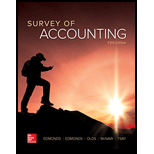
Survey Of Accounting
5th Edition
ISBN: 9781259631122
Author: Edmonds, Thomas P.
Publisher: Mcgraw-hill Education,
expand_more
expand_more
format_list_bulleted
Concept explainers
Question
Chapter 8, Problem 10E
To determine
Record the events of Corporation M in a horizontal statement model.
Expert Solution & Answer
Want to see the full answer?
Check out a sample textbook solution
Students have asked these similar questions
What is the division's margin of this financial accounting question?
Help
I need help with question B.
Chapter 8 Solutions
Survey Of Accounting
Ch. 8 - Prob. 1QCh. 8 - Prob. 2QCh. 8 - Prob. 3QCh. 8 - Prob. 4QCh. 8 - 5. What is the purpose of the articles of...Ch. 8 - 6. What is the function of the stock certificate?Ch. 8 - Prob. 7QCh. 8 - Prob. 8QCh. 8 - 9. What is a limited liability company? Discuss...Ch. 8 - Prob. 10Q
Ch. 8 - 11. What is the difference between contributed...Ch. 8 - Prob. 12QCh. 8 - Prob. 13QCh. 8 - 14. What is the meaning of each of the following...Ch. 8 - 15. What is the difference between cumulative...Ch. 8 - 16. What is no-par stock? How is it recorded in...Ch. 8 - 17. Assume that Best Co. has issued and...Ch. 8 - 18. If Best Co. issued 10,000 shares of 20 par...Ch. 8 - 19. What is the difference between par value stock...Ch. 8 - 20. Why might a company repurchase its own stock?Ch. 8 - 21. What effect does the purchase of treasury...Ch. 8 - 22. Assume that Day Company repurchased 1,000 of...Ch. 8 - 23. What is the importance of the declaration...Ch. 8 - 24. What is the difference between a stock...Ch. 8 - 25. Why would a company choose to distribute a...Ch. 8 - 26. What is the primary reason that a company...Ch. 8 - 27. If Best Co. had 10,000 shares of 20 par value...Ch. 8 - 28. When a company appropriates retained earnings,...Ch. 8 - Prob. 29QCh. 8 - Prob. 30QCh. 8 - Prob. 31QCh. 8 - 32. What are some reasons that a corporation might...Ch. 8 - Prob. 1ECh. 8 - Exercise 8-2 Effect of accounting events on the...Ch. 8 - Prob. 3ECh. 8 - Prob. 4ECh. 8 - Exercise 8-5 Characteristics of capital stock The...Ch. 8 - Exercise 8-6 Effect of issuing common stock on the...Ch. 8 - Exercise 8-7 Recording and reporting common and...Ch. 8 - Prob. 8ECh. 8 - Prob. 9ECh. 8 - Prob. 10ECh. 8 - Prob. 11ECh. 8 - Prob. 12ECh. 8 - Exercise 8-13 Recording and reporting treasury...Ch. 8 - Prob. 14ECh. 8 - Prob. 15ECh. 8 - Prob. 16ECh. 8 - Prob. 17ECh. 8 - Prob. 18ECh. 8 - Prob. 19PCh. 8 - Problem 8-20 Effect of business structure on...Ch. 8 - Prob. 21PCh. 8 - Prob. 22PCh. 8 - Problem 8-23 Recording and reporting stock...Ch. 8 - Prob. 24PCh. 8 - Prob. 25PCh. 8 - Problem 8-26 Treasury stock transactions and...Ch. 8 - Prob. 27PCh. 8 - Prob. 28PCh. 8 - Prob. 1ATCCh. 8 - ATC 8-3 Research Assignment Analyzing Skecherss...Ch. 8 - Prob. 4ATCCh. 8 - ATC 11-7 Ethical Dilemma Bad news versus very bad...
Knowledge Booster
Learn more about
Need a deep-dive on the concept behind this application? Look no further. Learn more about this topic, accounting and related others by exploring similar questions and additional content below.Similar questions
arrow_back_ios
SEE MORE QUESTIONS
arrow_forward_ios
Recommended textbooks for you
 Financial Accounting: The Impact on Decision Make...AccountingISBN:9781305654174Author:Gary A. Porter, Curtis L. NortonPublisher:Cengage LearningCentury 21 Accounting Multicolumn JournalAccountingISBN:9781337679503Author:GilbertsonPublisher:Cengage
Financial Accounting: The Impact on Decision Make...AccountingISBN:9781305654174Author:Gary A. Porter, Curtis L. NortonPublisher:Cengage LearningCentury 21 Accounting Multicolumn JournalAccountingISBN:9781337679503Author:GilbertsonPublisher:Cengage College Accounting, Chapters 1-27 (New in Account...AccountingISBN:9781305666160Author:James A. Heintz, Robert W. ParryPublisher:Cengage Learning
College Accounting, Chapters 1-27 (New in Account...AccountingISBN:9781305666160Author:James A. Heintz, Robert W. ParryPublisher:Cengage Learning College Accounting, Chapters 1-27AccountingISBN:9781337794756Author:HEINTZ, James A.Publisher:Cengage Learning,
College Accounting, Chapters 1-27AccountingISBN:9781337794756Author:HEINTZ, James A.Publisher:Cengage Learning,


Financial Accounting: The Impact on Decision Make...
Accounting
ISBN:9781305654174
Author:Gary A. Porter, Curtis L. Norton
Publisher:Cengage Learning

Century 21 Accounting Multicolumn Journal
Accounting
ISBN:9781337679503
Author:Gilbertson
Publisher:Cengage

College Accounting, Chapters 1-27 (New in Account...
Accounting
ISBN:9781305666160
Author:James A. Heintz, Robert W. Parry
Publisher:Cengage Learning

College Accounting, Chapters 1-27
Accounting
ISBN:9781337794756
Author:HEINTZ, James A.
Publisher:Cengage Learning,
Stockholders Equity: How to Calculate?; Author: Accounting University;https://www.youtube.com/watch?v=2jZk1T5GIlw;License: Standard Youtube License